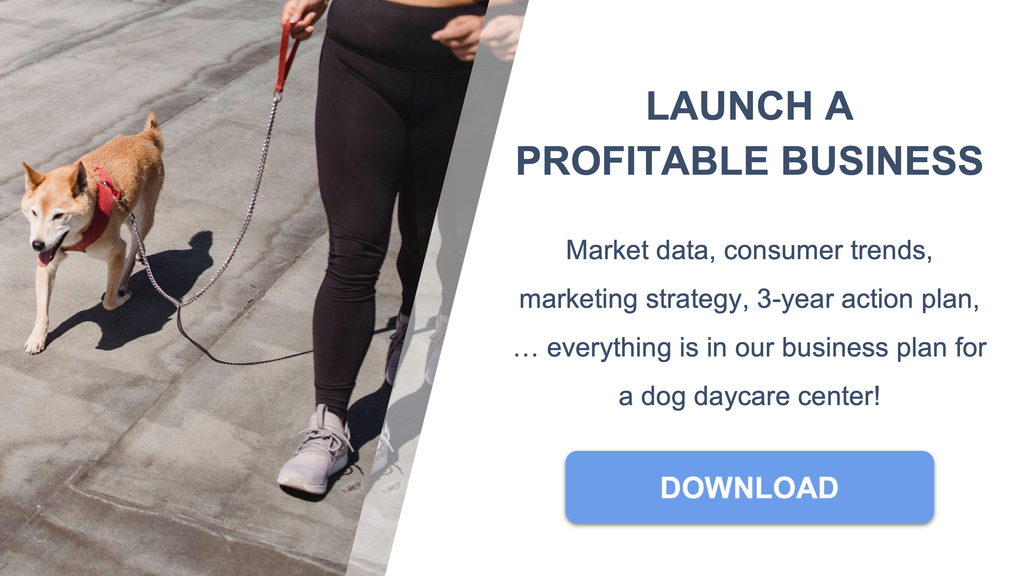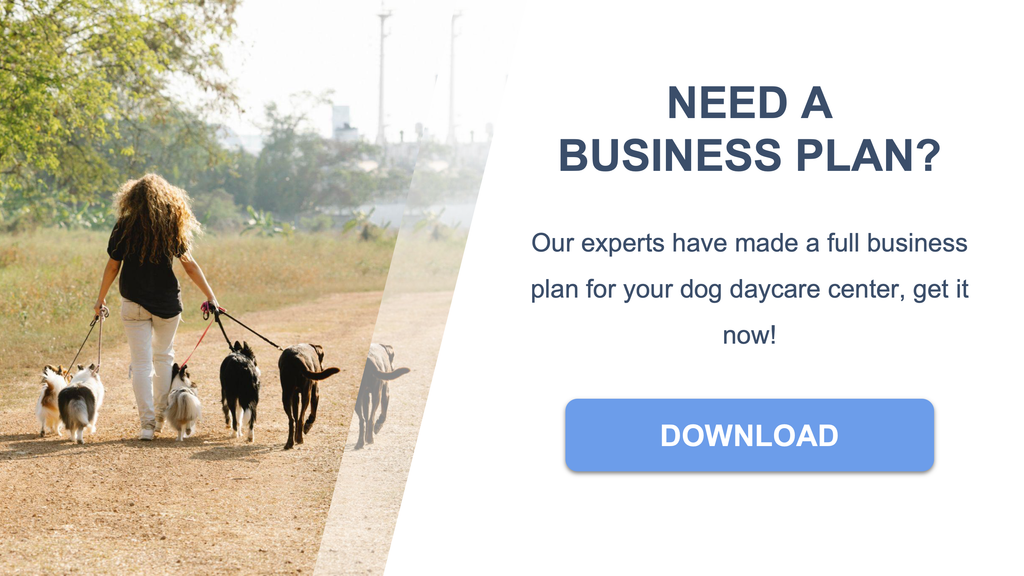This article was written by our expert who is surveying the pet-care industry and constantly updating the business plan for a dog daycare.

This guide explains, in clear numbers, how to launch and run a profitable dog daycare in October 2025.
You will see typical startup budgets, operating cost drivers, pricing tactics, break-even math, and the benchmarks investors expect. The figures below synthesize industry ranges from recent sources and hands-on operators so you can plan with realism.
If you want to dig deeper and learn more, you can download our business plan for a dog daycare. Also, before launching, get all the profit, revenue, and cost breakdowns you need for complete clarity with our dog daycare financial forecast.
Opening a dog daycare typically requires $45,000–$120,000 upfront for a standard commercial site, with lean home-based starts from ~$20,000 and upscale urban builds exceeding $150,000. At steady state, most centers target 60–70% weekday occupancy to break even, charging $25–$40 per dog-day and expanding margin with grooming, training, and boarding.
Well-run facilities report gross margins of 40–60% and net margins of 10–25%, depending on labor efficiency, space utilization, and add-on services. The tables and FAQs below turn these ranges into concrete staffing, pricing, and budget choices you can implement now.
| Topic | Key Numbers (Oct 2025) | Notes for Dog Daycare Operators |
|---|---|---|
| Startup budget | $45k–$120k typical; $20k lean; $150k+ upscale | Renovations, safety fit-out, deposits, equipment, software, licensing, and initial payroll. |
| Day rate (per dog) | $25–$40 (higher in dense urban/luxury) | Package pricing lowers unit price but boosts utilization and retention. |
| Break-even occupancy | ~60–70% of capacity | Assumes typical rent and staff ratios; add-ons accelerate profitability. |
| Gross / Net margin | Gross 40–60%; Net 10–25% | Labor is the main lever; grooming/training increase blended margin. |
| Core monthly costs | Payroll $4k–$10k+; Rent $2k–$8k; Insurance $500–$1,200 | Utilities $500–$2k; supplies $600–$2k; maintenance $250–$1.2k; software $200–$1k. |
| Staffing ratio | 1:10 to 1:15 (staff:dogs) | Higher supervision for puppies/large dogs; experienced handlers earn $15–$20/hr. |
| Add-on revenue | Grooming, training, boarding, retail, transport | Often 20–40%+ of total revenue at scale; grooming has strong contribution margin. |
| Customer KPIs | LTV $500–$2,500; CPA $50–$200 | Aim for retention >65%; optimize packages to lift LTV and weekday fill. |

How much capital do I need to open a dog daycare (property, licensing, equipment, staffing)?
Most new dog daycares open with $45,000–$120,000 in total startup investment.
Lean home-based setups can begin near $20,000, while premium urban builds with superior ventilation, flooring, and play-zone fit-outs can exceed $150,000. Your budget will concentrate in leasehold improvements, deposits, safe surfaces/fencing, and initial payroll to train staff before opening.
Plan line items for licensing, insurance binders, software, launch marketing, and working capital to cover the first 2–3 months of payroll and rent before you hit steady occupancy. Include contingency of 10–15% for overruns on flooring, drains, and noise control.
You’ll find a detailed, editable budget model in our dog daycare financial forecast.
Get expert guidance and actionable steps inside our dog daycare business plan.
You’ll find detailed market insights in our dog daycare business plan, updated every quarter.
What are the ongoing operating costs and how do they scale with the number of dogs?
Operating costs are dominated by payroll and facility overhead; both scale with capacity and occupancy.
At small to midsize centers, typical monthly ranges are payroll $4k–$10k+, rent $2k–$8k, insurance $500–$1,200, utilities $500–$2k, supplies $600–$2k, maintenance $250–$1.2k, and software $200–$1k. Variable spend (treats, cleaning supplies, laundry) grows roughly with dog-days; labor scales stepwise as you cross staffing ratio thresholds.
Expect labor to rise when you add a new playgroup or extend hours; rent and insurance act as fixed baselines that get diluted as you increase dog-days. Track cost per dog-day monthly to verify that higher volume is truly improving unit economics.
This is one of the strategies explained in our dog daycare business plan.
We cover this exact topic in the dog daycare business plan.
What revenue per dog should I expect (per day and per month) by region and services?
Daycare revenue averages $25–$40 per dog-day, higher in dense urban or premium markets.
Monthly revenue per dog depends on visit frequency and packaging; five-day weekly users produce 20–22 dog-days/month, while occasional users create 4–8 dog-days/month. Add-ons (enrichment, grooming, training) lift ARPU materially even without raising the day rate.
Boarding at $45–$55 per night further diversifies revenue and smooths seasonality, especially around holidays and travel peaks. Use tiered packages to stabilize weekday occupancy and increase lifetime value.
It’s a key part of what we outline in the dog daycare business plan.
This is one of the many elements we break down in the dog daycare business plan.
What occupancy rate do I need to break even and then turn a profit?
Most dog daycares break even around 60–70% weekday occupancy.
Break-even depends on your fixed costs (rent, admin wages, insurance) and your net contribution per dog-day after variable labor and supplies. If your contribution margin per dog-day is $18 and fixed costs are $12,000/month, you need ~667 dog-days/month to break even (~33 dogs/day over 20 weekdays).
Profitability improves quickly as weekday occupancy rises above 70% and you layer in add-ons and boarding revenue over the weekend. Monitor capacity by playgroup and hour to avoid peak-hour bottlenecks that cap utilization.
Get expert guidance and actionable steps inside our dog daycare business plan.
We cover this exact topic in the dog daycare business plan.
Which pricing strategies balance competitiveness and profitability?
- Create 5-, 10-, and 20-day packages with 5–15% discounts to raise commitment and weekday fill.
- Offer monthly memberships (e.g., 8, 12, 20 visits) with rollover limits to stabilize cash flow.
- Add enrichment blocks (structured play, agility, or nap-and-calm time) as paid upgrades.
- Price late pick-up/early drop-off and holiday surcharges clearly to protect labor costs.
- Bundle grooming or nail trims with daycare days to increase ticket size without extra acquisition cost.
What add-on revenue streams are the most profitable and sustainable?
- Grooming & bathing: high utilization of existing space; strong contribution margin.
- Training (group or 1:1): premium pricing; boosts differentiation and retention.
- Boarding/overnight: maximizes facility usage; strong seasonal demand around holidays.
- Retail (treats, chews, enrichment toys): incremental margin; supports training plans.
- Transportation (pick-up/drop-off): niche premium; improves access for busy owners.
What are typical gross and net margins in dog daycare, and how do they compare?
Dog daycare gross margins commonly sit between 40% and 60%.
Well-managed operators convert that into 10–25% net margin once rent, admin, and marketing are covered. Margins rise with efficient staff scheduling, high weekday utilization, and a meaningful mix of grooming/training revenue.
Compared with broader pet services, these net margins are competitive, especially when add-ons exceed 25–30% of total revenue. Track margin by service line monthly to protect blended profitability.
This is one of the strategies explained in our dog daycare business plan.
Get expert guidance and actionable steps inside our dog daycare business plan.
Which local regulations, licenses, and certifications affect profitability—and what do they cost?
Plan for business licensing, kennel permits, zoning compliance, insurance, and possible staff certifications.
| Requirement | Typical Cost & Time (Oct 2025) | Impact on Dog Daycare Operations |
|---|---|---|
| Business license | $50–$400; 1–4 weeks | Legal operating status; renew annually to avoid fines. |
| Kennel/daycare permit | $100–$800; 2–8 weeks | May include inspections for sanitation, noise, and capacity. |
| Zoning/occupancy | $0–$1,500+; 2–12 weeks | Approvals for use, parking, noise abatement, and occupancy limits. |
| Insurance (liability/property) | $500–$1,200/month | Coverage for incidents, property damage, and business interruption. |
| Animal care certifications | $0–$500 per staff; 1–4 weeks | Required in some municipalities; improves safety and credibility. |
| Health/sanitation inspections | Usually included in permit; periodic | Maintain logs for cleaning, vaccination verification, incident reports. |
| Fire/safety upgrades | $500–$5,000+ one-time | Alarms, exits, sprinklers as required; impacts renovation budget. |
What staffing model balances safety and profitability (ratios, roles, pay)?
Target a staff-to-dog ratio of 1:10 to 1:15, tightening ratios for puppies and high-energy groups.
Pay experienced handlers $15–$20/hour and use lead handlers or managers to oversee multiple playgroups and training quality. Build schedules around peak check-in/out windows to avoid overstaffing during midday lulls.
Cross-train staff for cleaning, client updates, and basic grooming tasks to increase flexibility and reduce idle time. Incentivize reliability and upsells with modest bonuses tied to safety KPIs and package conversions.
You’ll find detailed market insights in our dog daycare business plan, updated every quarter.
This is one of the many elements we break down in the dog daycare business plan.
Which marketing channels deliver the best ROI for acquiring and retaining daycare clients?
- Google Local + Ads: capture high-intent searches in your neighborhood.
- Instagram/TikTok with authentic dog updates: builds trust and repeat usage.
- Referral programs: reward existing clients and staff for warm introductions.
- Partnerships with vets, trainers, groomers, and pet retailers: low-CAC feeder network.
- Local sponsorships/events and rescue collaborations: strong brand goodwill and PR.
Which financial benchmarks should I monitor to manage profitability?
Track revenue per square foot, LTV, CPA, and staffing efficiency every month.
| Benchmark | Target Range (Oct 2025) | How to Use in a Dog Daycare |
|---|---|---|
| Revenue per sq ft (annual) | $100–$300+ / sq ft | Validates space productivity; informs lease decisions and layout changes. |
| LTV (customer lifetime value) | $500–$2,500 | Steer package design and retention spend; align with CPA caps. |
| CPA (cost per acquisition) | $50–$200 | Control ad bids and referral rewards; scale channels below LTV/3 rule. |
| Occupancy (weekday) | 60–85% | Schedule labor by playgroup; push packages to fill mid-week gaps. |
| Labor % of revenue | 35–50% | Primary margin lever; tighten ratios safely and stagger shifts. |
| Add-on mix | 20–40% of revenue | Grow grooming/training to raise blended margin without more dogs. |
| Client retention | >65% | Use memberships and consistent photo/video updates to reduce churn. |
What common mistakes reduce dog daycare profitability—and how do I avoid them?
- Under-staffing playgroups, causing safety incidents and refund requests.
- Over-building the facility and locking in a lease that utilization cannot support.
- Ignoring licensing and inspection timelines, delaying opening or expansions.
- Commodity pricing with no differentiation (no training/enrichment tiers).
- Poor cost tracking and no monthly margin by service line.
Conclusion
This article is for informational purposes only and should not be considered financial advice. Readers are encouraged to consult with a qualified professional before making any investment decisions. We accept no liability for any actions taken based on the information provided.
Want more on launching a profitable dog daycare?
Explore detailed plans, cost templates, and compliance checklists to move from idea to opening with confidence.
Sources
- Upmetrics — Dog Daycare Startup Costs
- Businessplan-templates — Dog Daycare Startup Costs
- MoeGo — Dog Daycare Owner Salary
- Businessplan-templates — Dog Daycare Running Costs
- Gingr — How Much Does a Dog Daycare Make?
- FinModelsLab — Doggy Daycare Startup Costs
- PetExec — Profitability Analysis
- Startup Financial Projection — CapEx for Doggy Daycare
- Dojo Business — Dog Daycare Business Plan
- Universal Class — Dog Day Care Expenses and Costs



